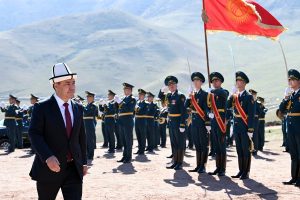Sadyr Japarov’s two post-revolutionary years in power have been eventful, both in domestic and geopolitical developments. Slow post-pandemic recovery, a dramatic escalation of the border conflict between Kyrgyzstan and Tajikistan, soaring inflation, the doubling of fuel and food prices, and the war on Ukraine all present enormous challenges for a politician with no previous international and state governance experience.
Indeed, many local commentators predicted that Japarov and his team would not last long in power. Yet, two years after storming into office the “revolutionary” government is still in place. Not only did Japarov’s government manage to survive severe water and electricity shortages, but it continues generating dynamism in domestic and regional affairs to the liking of his support base.
Through observations of Japarov’s two-year rule we can chart the elements of his success, but there is also growing public discontent related to repression, corruption, mismanagement, and Jaaprov’s unique style of governance.
Still a Tandem?
The recurrent question that many foreign observers of Kyrgyzstani politics ask is about the tandem – that is, the duo of Sadyr Japarov and Kamchybek Tashiev. Tashiev is not only the head of the State Committee for National Security but also the deputy head of the Cabinet of Ministers.
Many local analysts predicted a disintegration of the Japarov-Tashiev duo due to Tashiev’s strong ambitions. After all, such political unions in the past enjoyed a rather short life due to the lack of common ideological ground: Kulov-Bakiyev, Tashiev-Babanov, Jeenbekov-Isakov, and so on. But despite existing frictions, the Japarov-Tashiev tandem continues to function.
However, observing Tashiev’s growing interventions into the social and economic sectors and the deployment of his repressive apparatus upon all spheres of life, a critical question arises: Who really rules the country? Is it the president, Japarov, as the constitution says, or Tashiev and his all-powerful repressive security services?
Many insiders share the opinion that Japarov has a rather passive personality and allows himself to be led by others in many spheres of governance. As such, the centrality of the security services within state governance has become more evident in recent years. The State Committee for National Security has launched criminal cases not only against dissidents but also against members of the bureaucracy, creating a paralyzing dynamic among even lower and mid-level management and halting much needed reforms.
There are rumors that Tashiev might soon dethrone Japarov to take power himself. But such a scenario looks foolish from the perspective of simple regime survival strategies. In a country like Kyrgyzstan, one cannot rule based only on fear, and Tashiev needs Japarov’s charisma and ability to steer populist mobilization. So far, the two have devised a distribution of labor not in opposition to each other’s own rent-seeking activities.

































